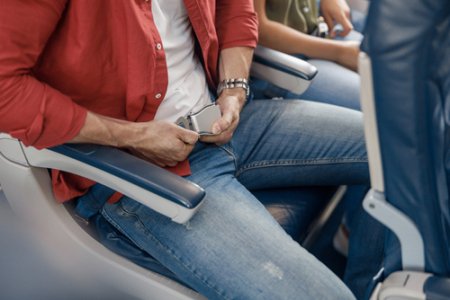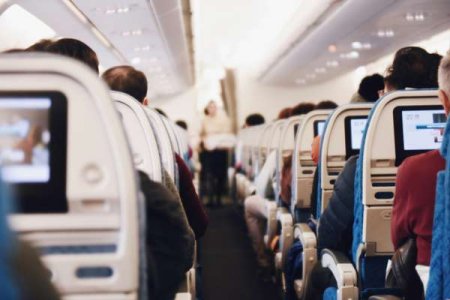Flight experts spill secrets: Stay safe during turbulence with these insider tips
Turbulence can be one of the more unnerving aspects of flying, even for the most seasoned travellers. It's the unseen force that can jostle an aircraft, unsettle stomachs, and cause concern among passengers.
But fear not, our members of the Seniors Discount Club, because flight experts have shared their insider tips on how to stay safe and comfortable when the ride gets bumpy.
The advice comes from a trio of aviation professionals: Terry Tozer, a former pilot and author, Nicky Kelvin, Editor at Large at The Points Guy travel site; and Jay Robert, a seasoned cabin crew member for Emirates and the founder of Fly Guy's Cabin Crew Lounge network.
Their insights are particularly timely following a rare but severe turbulence event on a Singapore Airlines flight.
So, where is the best place to sit on a plane to minimise the effects of turbulence? According to Terry Tozer, sitting over the wing is your best bet.
The aircraft is designed with the wings as its suspension points, making the middle of the plane the most stable area during turbulence.
However, Tozer noted that while this won't eliminate the effects of turbulence entirely, it can certainly reduce them.
He said: ‘The aircraft is suspended by the wings, so think of the rest of it like a springboard. The place where you'll feel turbulence the least is over the wing.’
‘It won't stop you from being affected entirely, though. I used to feel being up at the sharp end, we got the worst of it. On a long, thin aeroplane, the ends bounce up and down more than the middle,’ he added.
Nicky Kelvin added that passengers should also avoid sitting near the galley.
He explained: ‘Passengers may choose to sit in the middle of the plane over the wings for a smoother ride, but also away from the galleys, which have a lot of items in them that can become projectiles during extreme turbulence.’
‘Consider a window seat to avoid being directly under overhead compartments, which can open during extreme turbulence,’ he added.
But what about seatbelts? Should you really keep them fastened for the entire flight? The answer is a resounding yes.
Terry Tozer emphasised the importance of staying strapped in to prevent injuries from sudden drops or jolts.
'Unless you’re strapped in, if the aeroplane goes down, you’re going to go upwards,' he explained.

Jay Robert echoed this sentiment, urging passengers to follow the crew's lead and remain seated with their seatbelts fastened, especially when the seatbelt sign is illuminated.
‘Of course, people need to move around and use the lavatories on flights, but if you see the crew seated and the seatbelt sign is on, that is not the time to get up,’ he shared.
‘I can't tell you how many times I was seated in my jump seat because we had reported severe turbulence ahead, and passengers would try to use the toilet and even stand there and argue with me, saying, "Well, it's not bumpy!" Follow our lead and sit down!'
For those who have the option, booking a larger aircraft could also lead to a smoother experience.
Jay Robert's experience suggested that the larger the plane, the better it handles turbulence.
‘No plane is exempt from turbulence, but I've found that the bigger the plane, the better the ride. Most of my flying experience was with the Boeing 777 and the super jumbo Airbus A380. I noticed the A380 always seems to provide a smoother ride,’ he shared.
Understanding where and when turbulence is likely to occur can also help passengers prepare mentally for their journey.
Nicky Kelvin pointed out that extreme turbulence is more common around the equator and northern jet streams over the Pacific and Atlantic.
Websites like Turbli.com can provide forecasts for specific routes using the same data sources that pilots and airlines rely on for flight planning.
Despite the discomfort it can cause, Terry Tozer reassured passengers that dangerous turbulence is extremely rare.
‘An event like the Singapore Airlines one is very, very rare. I've only encountered turbulence that gave us a level change of a couple of thousand feet on one occasion in a career spanning 20 years or so,’ he assured.
‘That was in a 20-tonne four-engine Dash 7. The turbulence, caused by thunderstorm activity, lifted it up 1,000ft, and then we went down 1,000ft. And that wasn't as bad as the Singapore Airlines event.’
‘Turbulence is the last thing you need to worry about. Apart from an extreme event, all it will do is make you spill your coffee and it'll be uncomfortable. It won't cause the aeroplane to turn upside down,’ he continued.
Pilots are trained to anticipate and avoid turbulence whenever possible. They receive comprehensive weather information before flights, which highlights areas of potential clear air turbulence and convective activity like thunderstorms.
Weather radar helps pilots navigate around storm cells, but clear air turbulence, which occurs when air masses move in conflicting directions, can be more challenging to detect.
Terry said: ‘In the area where the Singapore Airlines flight was, it's well known that you can get some pretty aggressive thunderstorms.’
‘You've got weather radar that allows you to see those. But what you can't see is turbulence that's not associated with a storm cell—clear air turbulence.’
‘The meteorologist might mark on the chart that it's likely in an area—it happens when you have two air masses moving in conflicting directions. For example, near the bottom of a jet stream you'll nearly always get turbulence. Because it's going faster than the air around it, which churns it all up,’ he explained.
In conclusion, while turbulence is an unavoidable part of flying, there are steps you can take to ensure your safety and comfort.
Choose your seat wisely, always keep your seatbelt fastened, and trust in the expertise of the flight crew and the robustness of modern aircraft.
The severe turbulence experienced by Singapore Airlines left one passenger dead, and dozens more injured.
Source: 7NEWS Australia/YouTube
 We'd love to hear from you, members! What are your own strategies for staying calm and safe during flight turbulence? Share your stories and tips in the comments below.
We'd love to hear from you, members! What are your own strategies for staying calm and safe during flight turbulence? Share your stories and tips in the comments below.
But fear not, our members of the Seniors Discount Club, because flight experts have shared their insider tips on how to stay safe and comfortable when the ride gets bumpy.
The advice comes from a trio of aviation professionals: Terry Tozer, a former pilot and author, Nicky Kelvin, Editor at Large at The Points Guy travel site; and Jay Robert, a seasoned cabin crew member for Emirates and the founder of Fly Guy's Cabin Crew Lounge network.
Their insights are particularly timely following a rare but severe turbulence event on a Singapore Airlines flight.
So, where is the best place to sit on a plane to minimise the effects of turbulence? According to Terry Tozer, sitting over the wing is your best bet.
The aircraft is designed with the wings as its suspension points, making the middle of the plane the most stable area during turbulence.
However, Tozer noted that while this won't eliminate the effects of turbulence entirely, it can certainly reduce them.
He said: ‘The aircraft is suspended by the wings, so think of the rest of it like a springboard. The place where you'll feel turbulence the least is over the wing.’
‘It won't stop you from being affected entirely, though. I used to feel being up at the sharp end, we got the worst of it. On a long, thin aeroplane, the ends bounce up and down more than the middle,’ he added.
Nicky Kelvin added that passengers should also avoid sitting near the galley.
He explained: ‘Passengers may choose to sit in the middle of the plane over the wings for a smoother ride, but also away from the galleys, which have a lot of items in them that can become projectiles during extreme turbulence.’
‘Consider a window seat to avoid being directly under overhead compartments, which can open during extreme turbulence,’ he added.
But what about seatbelts? Should you really keep them fastened for the entire flight? The answer is a resounding yes.
Terry Tozer emphasised the importance of staying strapped in to prevent injuries from sudden drops or jolts.
'Unless you’re strapped in, if the aeroplane goes down, you’re going to go upwards,' he explained.

Former pilot Terry Tozer emphasised the importance of keeping seatbelts fastened during flights. Image source: Shutterstock
Jay Robert echoed this sentiment, urging passengers to follow the crew's lead and remain seated with their seatbelts fastened, especially when the seatbelt sign is illuminated.
‘Of course, people need to move around and use the lavatories on flights, but if you see the crew seated and the seatbelt sign is on, that is not the time to get up,’ he shared.
‘I can't tell you how many times I was seated in my jump seat because we had reported severe turbulence ahead, and passengers would try to use the toilet and even stand there and argue with me, saying, "Well, it's not bumpy!" Follow our lead and sit down!'
For those who have the option, booking a larger aircraft could also lead to a smoother experience.
Jay Robert's experience suggested that the larger the plane, the better it handles turbulence.
‘No plane is exempt from turbulence, but I've found that the bigger the plane, the better the ride. Most of my flying experience was with the Boeing 777 and the super jumbo Airbus A380. I noticed the A380 always seems to provide a smoother ride,’ he shared.
Understanding where and when turbulence is likely to occur can also help passengers prepare mentally for their journey.
Nicky Kelvin pointed out that extreme turbulence is more common around the equator and northern jet streams over the Pacific and Atlantic.
Websites like Turbli.com can provide forecasts for specific routes using the same data sources that pilots and airlines rely on for flight planning.
Despite the discomfort it can cause, Terry Tozer reassured passengers that dangerous turbulence is extremely rare.
‘An event like the Singapore Airlines one is very, very rare. I've only encountered turbulence that gave us a level change of a couple of thousand feet on one occasion in a career spanning 20 years or so,’ he assured.
‘That was in a 20-tonne four-engine Dash 7. The turbulence, caused by thunderstorm activity, lifted it up 1,000ft, and then we went down 1,000ft. And that wasn't as bad as the Singapore Airlines event.’
‘Turbulence is the last thing you need to worry about. Apart from an extreme event, all it will do is make you spill your coffee and it'll be uncomfortable. It won't cause the aeroplane to turn upside down,’ he continued.
Pilots are trained to anticipate and avoid turbulence whenever possible. They receive comprehensive weather information before flights, which highlights areas of potential clear air turbulence and convective activity like thunderstorms.
Weather radar helps pilots navigate around storm cells, but clear air turbulence, which occurs when air masses move in conflicting directions, can be more challenging to detect.
Terry said: ‘In the area where the Singapore Airlines flight was, it's well known that you can get some pretty aggressive thunderstorms.’
‘You've got weather radar that allows you to see those. But what you can't see is turbulence that's not associated with a storm cell—clear air turbulence.’
‘The meteorologist might mark on the chart that it's likely in an area—it happens when you have two air masses moving in conflicting directions. For example, near the bottom of a jet stream you'll nearly always get turbulence. Because it's going faster than the air around it, which churns it all up,’ he explained.
In conclusion, while turbulence is an unavoidable part of flying, there are steps you can take to ensure your safety and comfort.
Choose your seat wisely, always keep your seatbelt fastened, and trust in the expertise of the flight crew and the robustness of modern aircraft.
The severe turbulence experienced by Singapore Airlines left one passenger dead, and dozens more injured.
Source: 7NEWS Australia/YouTube
Key Takeaways
- Experts recommended sitting over the wing of an aircraft for the least experience of turbulence and avoiding seats near the galley to prevent being hit by potential projectiles.
- Always wearing your seatbelt throughout the flight is crucial for safety, as turbulence can occur unexpectedly and cause passengers not strapped in to be injured.
- Larger aircraft, such as the Boeing 777 and Airbus A380, may provide a smoother experience in turbulence due to their size and stability.
- Pilots use weather information and reports to anticipate and avoid turbulence where possible, and the occurrence of dangerous turbulence is very rare.







